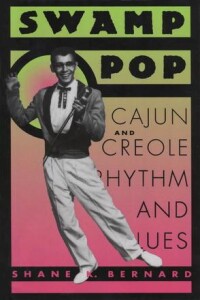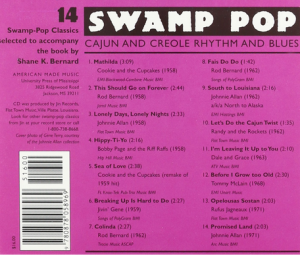 I didn’t think I knew what swamp pop was. Chances are you aren’t familiar with the term either. But if you are a member of the Baby Boom generation as I am, or if you’ve ever listened to “oldies” radio, you’ve heard swamp pop. The genre encompasses some of the best known and most popular rock ‘n’ roll songs of the late Fifties and early Sixties.
I didn’t think I knew what swamp pop was. Chances are you aren’t familiar with the term either. But if you are a member of the Baby Boom generation as I am, or if you’ve ever listened to “oldies” radio, you’ve heard swamp pop. The genre encompasses some of the best known and most popular rock ‘n’ roll songs of the late Fifties and early Sixties.
Swamp pop is the third major type of popular music invented by the Cajuns and Creoles of southwestern Louisiana. And according to author Shane Bernard, it deserves a place in the pop pantheon with Cajun and Zydeco music. After reading his book, I agree with him.
Really good writing about music is more rare than you might think. And Bernard has created something rare indeed, an excellent pop music book. Bernard originally wrote the kernel of the book as a history thesis. But he doesn’t come to the subject only as an academic. His father, Rod Bernard, had several regional hits as a swamp-popper in the Fifties and Sixties. His family contacts in the music business gained him access to many of the founders of the genre, whom he interviewed extensively for the book.
This book is excellently organized, well written, and fun to read. Bernard states his ideas clearly and backs them up with ample facts. Not only that, but it has a wonderful companion CD of 14 swamp pop classics, recorded from 1958 to 1971, most of which are discussed thoroughly in the book.
So what is swamp pop? I’ll let Bernard do the explaining:
I consider swamp pop to be a rhythm and blues hybrid that is influenced mainly by New Orleans rhythm and blues, country and western, and Cajun and black Creole music … indigenous to southeast Texas and the Acadiana region of south Louisiana. … (it) is a biracial genre that relies primarily on English lyrics and 1950s rhythm and blues instrumentation. … The swamp pop sound is typified by highly emotional vocals, simple, unaffected (and occasionally bilingual) lyrics, tripleting honky-tonk pianos, bellowing sax sections, and a strong rhythm and blues backbeat.
Some of the classics include Dale and Grace’s “I’m Leaving It Up to You,” Johnny Preston’s “Running Bear,” Freddy Fender’s “Before the Next Teardrop Falls” (all of which were number one hits in the U.S.), Phil Phillips’ “Sea of Love,” and Jimmy Clanton’s “Just a Dream,” which were Top Ten hits.
Bill Haley and the Comets had a big hit with their cover of the swamp pop hit “Later Alligator,” and the Rolling Stones did a version of Barbara Lynn’s “You’ll Lose a Good Thing.” The Beatles’ “Oh Darling” is Paul McCartney’s version of a slow swamp pop song. And Tom Waits and Keith Richards co-wrote a swamp pop number, “That Feel,” that Waits recorded in 1993.
Swamp pop was created by the young Cajun and Black Creole musicians of the Acadiana region. They were schooled in the music of their distinctive subcultures: Cajun, which was a French Louisiana country music hybrid; and French-speaking Black Creole (Afro-Caribbean) music, which later grew into what is now known as Zydeco. These youth were enamored of the R&B they heard on radio and records, made by Fats Domino, Chuck Berry, and Elvis.
So they created their own version of the new sound that was sweeping the nation and soon, the world. Their bands generally featured electric guitars, saxophones, stand-up bass, accordion and drums. They played and sang with emotional abandon, sometimes singing in both French and English. They were recorded in small local studios in towns with names like Opelousas, Ville Platte, and Lafayette, often in tiny rooms with one microphone for the whole band. In fact, that’s where the name “swamp pop” came from, because of the singing-into-a-barrel, swampy sound of those early 45 rpm singles.
Their music was infectious, danceable and influential on other rockers, including the Beatles and Rolling Stones, who eagerly collected American records. Ironically, swamp pop was dealt a near-mortal blow by the British Invasion of the mid-Sixties, but like its cousin rockabilly, it survived and has been the subject of numerous revivals. And in its home territory, it has always remained popular to some extent.
Bernard tells the whole story in detail, always focusing on the music and its makers. The 288-page book has more than two dozen photographs of the musicians, a helpful timeline and discography, a thorough bibliography, a subject index and a song index.
 Swamp pop is a fascinating musical subject, and Bernard, who was also the longtime official historian for McIlhenny Company, maker of Tabasco, has done it justice. I can’t recommend the book and its companion CD (also titled “Swamp Pop”) highly enough. The book is available from University Press of Mississippi and other online sources. The CD appears to be out of print, but you can find most or all of these classic tracks on Spotify and other streaming services. Here’s a screen capture of the back cover showing the songs and artists.
Swamp pop is a fascinating musical subject, and Bernard, who was also the longtime official historian for McIlhenny Company, maker of Tabasco, has done it justice. I can’t recommend the book and its companion CD (also titled “Swamp Pop”) highly enough. The book is available from University Press of Mississippi and other online sources. The CD appears to be out of print, but you can find most or all of these classic tracks on Spotify and other streaming services. Here’s a screen capture of the back cover showing the songs and artists.
(University Press of Mississippi, 1996)
